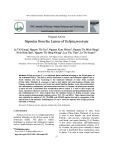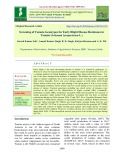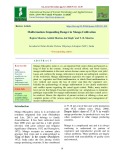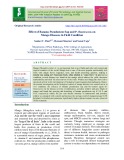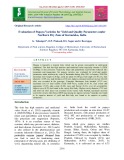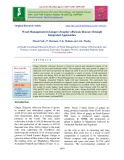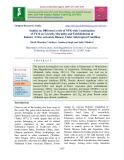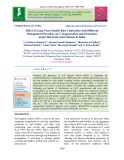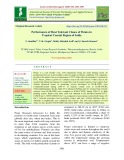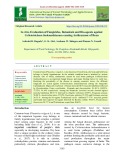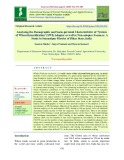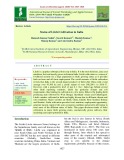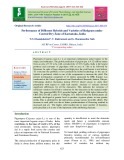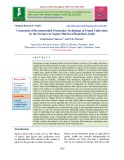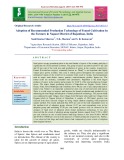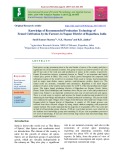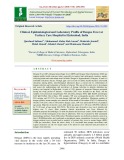
Sub-tropical India
-
Eclipta prostrata (L.) is a traditional herbal medicine belonging to the Eclipta genus in the Asteraceae family. This plant is widely distributed in tropical and subtropical regions such as South America and Asia. According to the traditional medicine of some Asian countries (China, India, Thailand), E. prostrata is used to treat hepatic and renal diseases, diabetes, skin diseases, respiratory disorders, cool blood, and stanch bleeding.
 7p
7p  viambani
viambani
 18-06-2024
18-06-2024
 1
1
 0
0
 Download
Download
-
Methane emission from various sources of biosphere contributes to the global warming/climate change related problems. Methane release from standing dead or age old trees, a new-fangled source for emission of CH4, was investigated. The experiment was carried out in tropical and subtropical forest ecoregions of Western Ghats of India. A standardized protocol was formulated for sampling and analysis of the gas samples collected from dead/decay trees. Based on our standardized protocol maximum and minimum emission of CH4 concentration was recorded.
 11p
11p  chauchaungayxua12
chauchaungayxua12
 29-07-2021
29-07-2021
 8
8
 2
2
 Download
Download
-
Early blight is the most devastating disease of tomato it is caused by pathogens i.e. Alternaria solani. In tropical and subtropical countries it creates hazardous effect. It is also a common problem in United Kingdom, Australia, India, Nepal and United States. It is one of the most common foliar diseases of tomatoes. The disease can occur over a wide range of climatic conditions, but is most prominent in areas with heavy dew, rainfall and high relative humidity. Every year sever disease appears in north India.
 6p
6p  chauchaungayxua10
chauchaungayxua10
 19-03-2021
19-03-2021
 18
18
 3
3
 Download
Download
-
Mango (Mangifera indica L.) is an important fruit crop in India and honored as king of fruit in the country. Among the several abiotic and biotic factors, mango malformation is the most serious disease causes up to 60 per cent yield losses and confines the mango cultivation in tropical and subtropical countries of the worldwide. Mango malformation expresses two types of symptoms on plant i.e. vegetative and floral malformation, in which floral malformation is very virulent and causes the loss of entire crop than the vegetative one.
 17p
17p  chauchaungayxua11
chauchaungayxua11
 23-03-2021
23-03-2021
 6
6
 1
1
 Download
Download
-
Mango (Mangifera indica L.) is an important fruit crop of India and other sub-tropical and tropical countries of the world. Mango fruit is one of the most popular, nutritionally rich fruits with unique flavor, fragrance, taste, and health promoting qualities, making it number one among new functional foods, often labelled as “super fruits". In pre-harvest condition, several diseases are found on the mango which reduces the yield, decreases marketability and shelf life after harvest of the fruits.
 8p
8p  cothumenhmong9
cothumenhmong9
 18-01-2021
18-01-2021
 12
12
 1
1
 Download
Download
-
Papaya is basically a tropical fruit, which can be grown successfully in subtropical conditions. The fruit has high nutritive and medicinal value especially vitamin A (2020 IU/l00g). It also possesses vitamin B, folate and pantothenic acid besides minerals like potassium and magnesium. Six papaya varieties was evaluated for yield and quality parameters under northern dry zone of Karnataka during May 2015 to January 2016.
 8p
8p  gaocaolon9
gaocaolon9
 22-12-2020
22-12-2020
 10
10
 2
2
 Download
Download
-
Ginger (Zingiber officinale Roscoe) is grown in tropical and subtropical regions of the world for its spice and medicinal values. The emergence and early growth of ginger is inherently slow and weed growth can impact on yield. It has slow initial growth rate and shallow root system. As a result, it is invaded by a variety of weeds. A field experiment was carried out during 2015-16 and 2016-17 in randomized block design with three replications under AICRP on Weed Management at College of Horticulture and Forestry, CAU, Pasighat, Arunachal Pradesh, India with nine treatments.
 7p
7p  gaocaolon9
gaocaolon9
 22-12-2020
22-12-2020
 12
12
 2
2
 Download
Download
-
Sugarcane, (Saccharum officinarum) L., is one of the several species of tall perennial true grasses of the genus Saccharum. Sugarcane is the source of sugar in all tropical and subtropical countries of the world that belongs to family Poaceae. The various physical parameters of sugarcane crops such as Length, diameter of cane and node distance, were studied in Kawardha district, (C.G.).
 4p
4p  trinhthamhodang9
trinhthamhodang9
 16-12-2020
16-12-2020
 13
13
 2
2
 Download
Download
-
The present investigation was under taken at Department of Horticulture, Sam Higginbottom University of Agriculture, Technology and Sciences, Allahabad, India during 2013-14.
 5p
5p  chauchaungayxua8
chauchaungayxua8
 03-10-2020
03-10-2020
 13
13
 1
1
 Download
Download
-
Studying the dynamics of soil organic carbon (SOC) is important for understanding the C stabilization into different pools. Carbon sequestration in soils has the potential to curb global warming besides maintaining sustainability of agricultural system under tropical and subtropical climate.
 8p
8p  chauchaungayxua8
chauchaungayxua8
 03-10-2020
03-10-2020
 12
12
 1
1
 Download
Download
-
Potato is a cool weather crop, with temperature being the main limiting factor on production; however it grows under a diverse range of climatic conditions. The vegetative growth of the plant is best at a temperature of 24°C while tuber development is favoured at 18°C. Hence, potato is grown as a summer crop in the hills and as a winter crop in the tropical and subtropical regions.
 7p
7p  trinhthamhodang1215
trinhthamhodang1215
 23-09-2020
23-09-2020
 11
11
 2
2
 Download
Download
-
In India, disease incidence has been reported to vary between 24.59 to 51.72 % Sharma and Sugha (1995). As a disease of minor important but during the last few year bean anthracnose has appeared as a potential threat to the (Sacc and Magnus) Briosi and Cavara is a major limiting factor in reduction of yield in subtropical and temperate regions. Anthracnose is mainly a seed-borne disease caused by a fungus which has a wide host range on many legume species (Goswami et al., 2011).
 8p
8p  trinhthamhodang1215
trinhthamhodang1215
 23-09-2020
23-09-2020
 8
8
 2
2
 Download
Download
-
Ayurveda is one of the oldest systems of medicine that uses plants and their extracts for treatment and managing of various diseased states. Nyctanthes arbortristis Linn (Oleaceae) is an important large flowering shrub of tropical and subtropical regions of the world that has been conventionally used to provoke menstruation, for treatment of scabies and other skin infections, as hair tonic, chalogogue, laxative, diaphoretic, diuretic, in treatment of arthritis, malaria, bronchitis and as anthelmintic. Nyctanthes arbortristis is one of the most useful conventional plants in India.
 18p
18p  trinhthamhodang1215
trinhthamhodang1215
 23-09-2020
23-09-2020
 9
9
 1
1
 Download
Download
-
Wheat (Triticum aestivum L.) is world’s most widely cultivated food grain crop. At initial decades of 21st century, one probability of a great famine appeared in the world due to long drought in tropics and subtropics and at the same time it appeared more dangerously because of the climate change threat. System of Wheat Intensification (SWI) which is somewhat based on the fundamental principles of System of Rice Intensification (SRI) is a new wheat cultivation technique which might act as a significantly new weapon as a part of climate-smart farming.
 10p
10p  angicungduoc6
angicungduoc6
 22-07-2020
22-07-2020
 8
8
 1
1
 Download
Download
-
Litchi is a popular subtropical fruit crop in India. It is the most delicious, juicy and nutritious fruit and mostly grown in Eastern India. Litchi cultivation is a source of livelihood security for a large population in litchi growing states as it provides both on-farm and off-farm employment. The world scenario of litchi cultivation reveals that India is the second-largest producer of litchi after China with a total acreage over 93,300 ha and a yearly output of over 568,200 t in 2016-17. However, with a productivity level of just 6.
 14p
14p  angicungduoc6
angicungduoc6
 22-07-2020
22-07-2020
 11
11
 2
2
 Download
Download
-
Performance of different hybrids and varieties of redgram under central dry zone of Karnataka, India
Pigeonpea (Cajanus cajan L.) is an important multipurpose pulse legume in the tropics and subtropics. The global production of pigeon pea is 4.32 million tonnes from an area of 5.32 m ha with a productivity of 813.2 kg/ha. India is the largest producer and consumer of pigeonpea with an area of 3.86 m ha followed by Myanmar. In spite of huge demand and high price the yield barrier is not broken. To overcome the problem of low productivity hybrid technology or the use of hybrids is preferred; which is one of the components to increase the yield.
 4p
4p  kethamoi6
kethamoi6
 29-06-2020
29-06-2020
 13
13
 2
2
 Download
Download
-
Seed spices occupy prominent place in the total basket of spices of the country and play a significant role in our national economy. The group of spices account for about 37 per cent and 18 per cent of the total area and production of spices in the country, respectively. Fennel (Foeniculum vulgare) commonly known as ‘Saunf’ is an important and highly valued spice grown in India.
 12p
12p  kethamoi6
kethamoi6
 29-06-2020
29-06-2020
 15
15
 2
2
 Download
Download
-
Seed spices occupy prominent place in the total basket of spices of the country and play a significant role in our national economy. The group of spices account for about 37 per cent and 18 per cent of the total area and production of spices in the country, respectively. Fennel (Foeniculum vulgare) commonly known as ‘Saunf’ is an important and highly valued spice grown in India.
 8p
8p  chauchaungayxua6
chauchaungayxua6
 26-06-2020
26-06-2020
 15
15
 2
2
 Download
Download
-
Seed spices occupy prominent place in the total basket of spices of the country and play a significant role in our national economy. The group of spices account for about 37 per cent and 18 per cent of the total area and production of spices in the country, respectively. Fennel (Foeniculum vulgare) commonly known as ‘Saunf’ is an important and highly valued spice grown in India.
 8p
8p  chauchaungayxua6
chauchaungayxua6
 26-06-2020
26-06-2020
 14
14
 1
1
 Download
Download
-
Dengue Fever (DF), Dengue hemorrhagic fever (DHF) and Dengue Shock Syndrome (DSS) are topmost public health concerns today, especially in tropical and subtropical countries, mainly involving urban and semi-urban areas. In India, Dengue is hyperendemic (Category A) and is a notifiable infectious disease. Though gaps exist in terms of public health measures and health education among public, microbiological laboratory plays a crucial role in confirmation of dengue infection and estimation of burden of disease.
 9p
9p  angicungduoc5
angicungduoc5
 12-06-2020
12-06-2020
 11
11
 1
1
 Download
Download
CHỦ ĐỀ BẠN MUỐN TÌM









